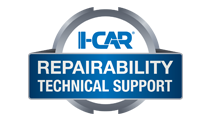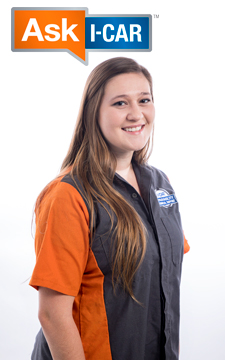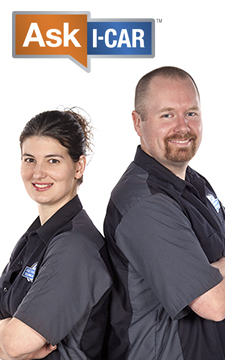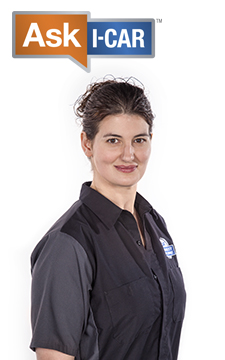OEM Restraints System Part Replacement Search
2023 Chevrolet Colorado Crew Cab
Share:
|
DISABLE PROCEDURE AND TIME (Always Check Service Manual)
1. Turn the steering wheel so that the vehicles wheels are pointing straight ahead.2. Place the ignition in the OFF position.
3. Disconnect the negative battery cable from the battery.
4. Wait 2 minutes before working on the system.
REV: 03/2025
PARTS THAT MUST BE REPLACED FOLLOWING A DEPLOYMENT
Exceeds Minor Outer Body Panel Cosmetic Distortion without Airbag Deployment:•Front and/or Side Impact Sensors
-The impact sensor replacement policy requires replacing sensors in the area of the accident damage. The area of accident damage is defined as the portion of the vehicle which is crushed, bent, or damaged due to a collision. If the impact sensor or the mounting structure of the impact sensor is damaged, the impact sensor must be replaced.
-Replace the impact sensor whether or not the air bags have deployed.
-Replace the impact sensor even if it appears to be undamaged.
-Impact sensor damage which is not visible, such as slight bending of the mounting bracket or cuts in the wire insulation, can cause improper operation of the SIR system. Do not try to determine whether the impact sensor is undamaged, replace the impact sensor. Also, if you follow a diagnostic trouble code (DTC) procedure and a malfunctioning impact sensor is indicated, replace the impact sensor.
Pretensioner Deployment:
•Front and/or Side Impact Sensors
-The impact sensor replacement policy requires replacing sensors in the area of the accident damage. The area of accident damage is defined as the portion of the vehicle which is crushed, bent, or damaged due to a collision. If the impact sensor or the mounting structure of the impact sensor is damaged, the impact sensor must be replaced.
-Replace the impact sensor whether or not the air bags have deployed.
-Replace the impact sensor even if it appears to be undamaged.
-Impact sensor damage which is not visible, such as slight bending of the mounting bracket or cuts in the wire insulation, can cause improper operation of the SIR system. Do not try to determine whether the impact sensor is undamaged, replace the impact sensor. Also, if you follow a diagnostic trouble code (DTC) procedure and a malfunctioning impact sensor is indicated, replace the impact sensor.
•Seat Belt Anchor and/or Retractor Pretensioners
•Inflatable Restraint Sensing and Diagnostic Module (SDM) or Restraints Control Module (RCM)-Replace only if module has set DTC B0052 (or other related SDM DTCs) or DTC B1A33 (or other related RCM DTCs) and will not clear.
Seat Side Airbag Deployment:
•Steering Column
•Steering Wheel
•Front and/or Side Impact Sensors
•Roof Rail Airbag
•Seat Back Cover
•Seat Side Air Bag
•Seat Belt Anchor and/or Retractor Pretensioners
•Inflatable Restraint Sensing and Diagnostic Module (SDM) or Restraints Control Module (RCM)-Replace only if module has set DTC B0052 (or other related SDM DTCs) or DTC B1A33 (or other related RCM DTCs) and will not clear.
Frontal Airbag Deployment:
•Steering Column
•Steering Wheel
•Steering Wheel Airbag
••Front and/or Side Impact Sensors
•Instrument Panel Airbag
•Knee Airbag
•Seat Side Air Bag
•Seat Belt Anchor and/or Retractor Pretensioners
•Inflatable Restraint Sensing and Diagnostic Module (SDM) or Restraints Control Module (RCM)-Replace only if module has set DTC B0052 (or other related SDM DTCs) or DTC B1A33 (or other related RCM DTCs) and will not clear.
Replace any seat belt system that was in use during the collision serious enough to deploy any automatic restraint device such as air bags and seat belt pretensioners. This not only includes seat belt systems in use by people of adult size, but seat belt systems used to secure child restraints, infant carriers and booster seats, including LATCH system and top tether anchorages
Replace any seat belt system that has torn, worn, or damaged components. This not only includes adult seat belt systems, but built-in child restraints and LATCH system
components, if any.
Replace any seat belt system if you are doubtful about its condition. This not only includes adult seat belt systems, but built-in child restraints, LATCH system
components, and any restraint system used to secure infant carriers, child restraints,
and booster seats.
Do NOT replace single seat belt system components in vehicles that have been in a collision as described above. Always replace the entire seat belt system with the buckle, guide
and retractor assembly, which includes the latch and webbing material.
PARTS THAT MUST BE INSPECTED AND REPLACED IF DAMAGED
1.-After ANY collision, perform the following belt operational and functional checks:•Turn the ignition switch to the ON position. Verify proper operation of the seat belt reminder lamp with the belt buckled and with the belt unbuckled.
•For each seating position:
••Inspect the shoulder belt guide to ensure that the seat belt webbing is seated flat in the guide slot and that the seat belt webbing does not bind.
••Verify that the seat belt buckle is accessible.
••Fully extend the seat belt webbing. Verify that the seat belt webbing does not have any twists or tears.
••Allow the seat belt webbing to retract. Verify that the seat belt webbing returns freely and completely back into the retractor.
••Snap the seat belt latch plate into the buckle. Sharply tug on the seat belt latch plate and the buckle. Verify that the seat belt latch plate and the buckle remain locked when tugged.
••Push the button on the buckle. Verify the seat belt latch plate releases easily from the buckle and the button returns to its original position.
2.-In instances of vehicle collision where damage is limited to minor outer body panel cosmetic distortion: visually inspect vehicle for extent of damage, repair and replace components as necessary.
3.-In instances of vehicle collision where damage exceeds minor outer body panel cosmetic distortion, unrelated components can be subject to damage outside of obvious visual detection method in the area of impact. The table below references components requiring inspection or replacement to promote a safe and quality repair. Some inspections may require disassembly of vehicle components or additional functional tests. If you detect any damage, replace the component.
Exceeds Minor Outer Body Panel Cosmetic Distortion without Airbag Deployment:
•Brake Pedal—Inspect
•The steering column—Inspect the steering column for bending, twisting, buckling or any type of damage.
• Steering Wheel—Inspect
• Steering Wheel Airbag—Visually inspection the top trim cover of the airbag module for deformation, distortion, or indentations as a result of damage. Replace if found.
•Impact Sensors Mounting Points and Hardware—Inspect
•Instrument Panel Cross Car Beam—Inspect
•Instrument Panel Knee Bolsters and Mounting Points—Inspect
•Instrument Panel Mounting Points and Instrument Panel Brackets, Braces, etc.—Inspect
•Instrument Panel Air Bag Mounting Points and Hardware—Inspect
•Instrument Panel Airbag—Inspect
•Knee Airbag—Inspect
•Roof and Headliner Mounting Points—Inspect
•Door trim assembly On Side of Impact.—Visually inspect door trim assembly for deformation or distortion as a result of damage. Replace if deformation or distortion is found.
•Roof Rail Airbag—On Side of Impact. If not deployed, visually inspect roof trim for deformation or distortion as a result of damage. Replace if found.
•Seats and Seat Mounting Points
•Seat Back Cover—If Side Air Bag(s) Deployed. If not deployed, visually inspect seat back cover and top trim cover of the airbag modules for deformation or distortion as a result of damage. Replace if deformation or distortion is found.
•Seat Belt System—This applies to seat belt systems in use by people of adult size, seat belt systems used to secure child restraints, infant carriers, and booster seats, including LATCH system and top tether anchorages.
Do NOT replace single seat belt system components in vehicles that have been in a collision as described above. Always replace the entire seat belt system with the buckle, guide, and retractor assembly, which includes the latch and webbing material.
•Seat Belt Anchor and/or Retractor Pretensioners—Inspect
•Seat Belt Anchor and/or Retractor Pretensioners Mounting Points and Hardware—Visually verify the seat belt retractor units are securely attached and the seat belt anchor bolts are secure.
Pretensioner Deployment:
•Brake Pedal—Inspect
•The steering column—Inspect the steering column for bending, twisting, buckling or any type of damage.
• Steering Wheel—Inspect
• Steering Wheel Airbag—Visually inspection the top trim cover of the airbag module for deformation, distortion, or indentations as a result of damage. Replace if found.
•Impact Sensors Mounting Points and Hardware—Inspect
•Instrument Panel Cross Car Beam—Inspect
•Instrument Panel Knee Bolsters and Mounting Points—Inspect
•Instrument Panel Mounting Points and Instrument Panel Brackets, Braces, etc.—Inspect
•Instrument Panel Air Bag Mounting Points and Hardware—Inspect
•Instrument Panel Airbag—Inspect
•Knee Airbag—Inspect
•Roof and Headliner Mounting Points—Inspect
•Door trim assembly On Side of Impact.—Visually inspect door trim assembly for deformation or distortion as a result of damage. Replace if deformation or distortion is found.
•Trim Mounting Points and Hardwares—On Side of Impact
•Roof Rail Airbag Mounting Points and Hardware—On Side of Impact
•Seats and Seat Mounting Points—Inspect
•Seat Back Cover—If Side Air Bag(s) Deployed. If not deployed, visually inspect seat back cover and top trim cover of the airbag modules for deformation or distortion as a result of damage. Replace if deformation or distortion is found.
•Seat Belt Anchor and/or Retractor Pretensioners Mounting Points and Hardware—Visually verify the seat belt retractor units are securely attached and the seat belt anchor bolts are secure.
•Inflatable Restraint Sensing and Diagnostic Module (SDM) or Restraints Control Module (RCM) Mounting Points and Hardware
Seat Side Airbag Deployment:
•Brake Pedal—Inspect
• Steering Wheel Airbag—Visually inspection the top trim cover of the airbag module for deformation, distortion, or indentations as a result of damage. Replace if found.
•Impact Sensors Mounting Points and Hardware—Inspect
•Instrument Panel Cross Car Beam—Inspect
•Instrument Panel Knee Bolsters and Mounting Points—Inspect
•Instrument Panel Mounting Points and Instrument Panel Brackets, Braces, etc.—Inspect
•Instrument Panel Air Bag Mounting Points and Hardware—Inspect
•Instrument Panel Airbag—Inspect
•Knee Airbag—Inspect
•Roof and Headliner Mounting Points—Inspect
•Door trim assembly On Side of Impact.—Visually inspect door trim assembly for deformation or distortion as a result of damage. Replace if deformation or distortion is found.
•Trim Mounting Points and Hardwares—On Side of Impact
•Seats and Seat Mounting Points—Inspect
•Seat Side Air Bag Mounting Points and Hardware-If Side Air Bag(s) Deployed
•Seat Adjuster—Inspect
•Seat Back Frame—Inspect
•Seat Cushion Frame—Inspect
•Seat Cushion Side Covers and Switches—Inspect
•Seat Recliner and Cover—Inspect
•Seat Belt Anchor and/or Retractor Pretensioners Mounting Points and Hardware—Visually verify the seat belt retractor units are securely attached and the seat belt anchor bolts are secure.
•Inflatable Restraint Sensing and Diagnostic Module (SDM) or Restraints Control Module (RCM) Mounting Points and Hardware
Frontal Airbag Deployment:
•Brake Pedal—Inspect
•Steering Wheel Air Bag Coil and Coil Wiring Pigtail—Inspect
•Steering Wheel Air Bag Mounting Points and Hardware—Inspect
•Impact Sensors Mounting Points and Hardware—Inspect
•Instrument Panel Cross Car Beam—Inspect
•Instrument Panel Knee Bolsters and Mounting Points—Inspect
•Instrument Panel Mounting Points and Instrument Panel Brackets, Braces, etc.—Inspect
•Instrument Panel Air Bag Mounting Points and Hardware—Inspect
•Roof and Headliner Mounting Points—Inspect
•Seats and Seat Mounting Points—Inspect
•Seat Back Cover—If Side Air Bag(s) Deployed. If not deployed, visually inspect seat back cover and top trim cover of the airbag modules for deformation or distortion as a result of damage. Replace if deformation or distortion is found.
•Seat Side Air Bag Mounting Points and Hardware-If Side Air Bag(s) Deployed
•Seat Belt Anchor and/or Retractor Pretensioners Mounting Points and Hardware—Visually verify the seat belt retractor units are securely attached and the seat belt anchor bolts are secure.
•Inflatable Restraint Sensing and Diagnostic Module (SDM) or Restraints Control Module (RCM) Mounting Points and Hardware
| Additional Information |
*This matrix does not currently contain all production vehicles sold in the United States. The contents were developed in cooperation with AudaExplore, a Solera company. The contents are based on the information available at the time of publication. Updates and additions will be posted as they become available. To ensure that you are using the most recent information, always refer to vehicle maker technical information.









